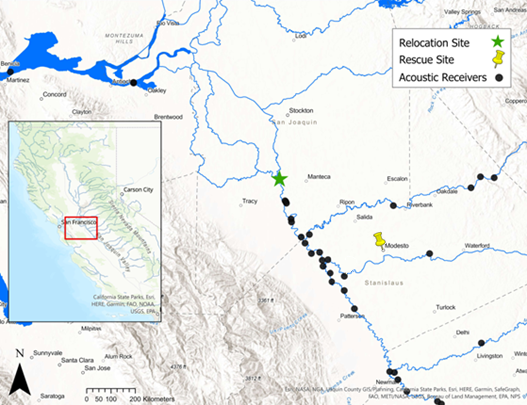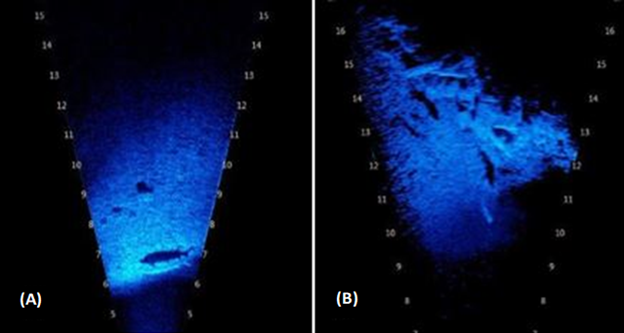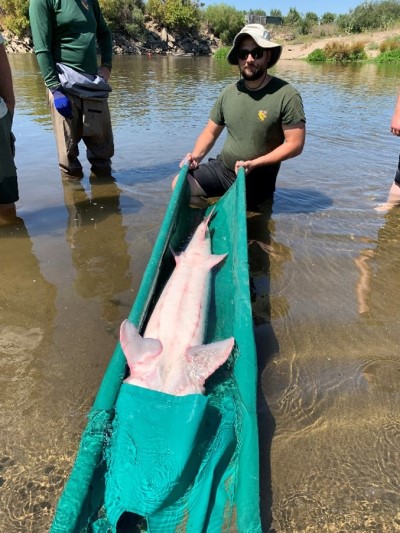Species Status
White Sturgeon (Acipenser transmontanus) are the largest freshwater fish species in North America and occupy the San Francisco Bay as well as the Sacramento and San Joaquin Rivers. They support a large recreational fishery in California and, although they are not currently listed under the Endangered Species Act, they are considered a state Species of Special Concern. Most White Sturgeon spawn in the Sacramento River and its associated tributaries, but recent studies have concluded that White Sturgeon will use the San Joaquin River to spawn during wet and dry years (Jackson et al. 2016). The amount of time that White Sturgeon occupy the tributaries of the San Joaquin River is less understood and not yet documented. Further details about the status of the population can be found online at the CDFW White Sturgeon Enhanced Status Report.
Necessity of Rescue
In April 2021, pictures were passed along to CDFW staff by a citizen which showed several sturgeon present in the lower Tuolumne River, a tributary to the San Joaquin River, Stanislaus County. These fish continued to be observed by this individual while river temperatures were increasing towards 30°C in July (Figure 1), which would exceed the temperature range (25°C) for optimal growth and metabolism for White Sturgeon (Cech et al. 1984; Israel et al. 2009). CDFW managers decided that relocating these fish was necessary to keep these sturgeon in good health, reduce the opportunity for poaching, and use this opportunity to tag the first sturgeon in a tributary to the San Joaquin River. A landowner allowed CDFW staff river access to perform a rescue and to relocate these fish to deeper habitat.
 Figure 1. Thermal limit (25°C) for White Sturgeon optimal growth in relation to Tuolumne River mean daily flow and temperature from 1 Mar 2021–1 Feb 2022 in Modesto, CA (RKM 27; MOD; USGS 11290000).
Figure 1. Thermal limit (25°C) for White Sturgeon optimal growth in relation to Tuolumne River mean daily flow and temperature from 1 Mar 2021–1 Feb 2022 in Modesto, CA (RKM 27; MOD; USGS 11290000).
Methods
On June 22, 2021, CDFW staff conducted a rescue and tagging effort due to high river temperatures and low flow conditions, creating shallow river depths potentially obstructing migration to suitable habitat. This rescue effort extended over two days and any sturgeon captured were successfully relocated to a downstream portion of the San Joaquin River, where passage to the San Francisco Estuary is unobstructed. Sturgeon were captured by extending two 30-m trammel nets by boat and anchoring them along the river bottom parallel with streamflow. Nets were checked every 15 minutes, or when excessive movement was observed in any net. Each sturgeon was implanted with an acoustic tag (Vemco V16, 69 kHz), as well as a Passive Integrated Transponder tag. After tagging, each fish was transported individually by truck, with an aerated holding box, then released at Mossdale Crossing at approximately SJR RKM 90.1 (37.787°, –121.307°). These fish were later tracked by acoustic receivers (Vemco VR2W, 69 kHz) positioned throughout the basin (Figure 2). Further monitoring was conducted after the relocation effort using sonar (ARIS Explorer 1800) to determine the presence of any additional sturgeon (Figure 3).
 Figure 2. Acoustic receiver locations with the SFE and SJR basin. Rescue site is approximate and located on the Tuolumne River downstream of Modesto. Relocation site is at Mossdale Crossing (SJR RKM 90.1).
Figure 2. Acoustic receiver locations with the SFE and SJR basin. Rescue site is approximate and located on the Tuolumne River downstream of Modesto. Relocation site is at Mossdale Crossing (SJR RKM 90.1).
 Figure 3. Sonar image captured by ARIS on 10 Aug 2021 confirming presence of one additional Sturgeon following tagging and relocation event. Image captured on 31 Aug 2021 confirming presence of two sturgeon holding at same location (Tuolumne River downstream of Modesto). CDFW images.
Figure 3. Sonar image captured by ARIS on 10 Aug 2021 confirming presence of one additional Sturgeon following tagging and relocation event. Image captured on 31 Aug 2021 confirming presence of two sturgeon holding at same location (Tuolumne River downstream of Modesto). CDFW images.
Results
 Figure 4. Adult White Sturgeon held in a cradle for safe handling before tagging and during transportation. CDFW photo.
Figure 4. Adult White Sturgeon held in a cradle for safe handling before tagging and during transportation. CDFW photo.
Three White Sturgeon were successfully captured by trammel net and relocated to a downstream portion of the San Joaquin River. One sturgeon successfully migrated straight to the ocean after relocation. The second sturgeon migrated upstream of the relocation site and remained in the San Joaquin, however; this fish has not been detected by receivers since March 2022. The third sturgeon has not been detected after relocation on any receiver in our study to date. After relocation, two more sturgeon were observed by ARIS (Figure 3), but these fish were not relocated due shallow depths along the San Joaquin River at the release location. These fish were observed through September until floating vegetation and shallow depths made boat passage impossible. After flows increased in December and monitoring continued, these two sturgeon were no longer observed. Figure 4 shows a White Sturgeon cradled upside-down which helps to calm the large fish before tagging.
Monitoring
- United States Fish and Wildlife Service
- CDFW staff
Partners
- United States Fish and Wildlife Service
- Anonymous Landowner
- Private Citizen
References
- Cech, J. J., S. J. Mitchell, and T. E. Wragg. 1984. Comparative growth of juvenile White Sturgeon and striped bass: Effects of temperature and hypoxia. Estuaries 7, 12–18. Available from: https://doi.org/10.2307/1351952.
- Israel, J., A. Drauch, and M. Gingras. 2009. Life History Conceptual Model for White Sturgeon (Acipenser transmontanus). Delta Regional Ecosystem Restoration Implementation Plan (DRERIP). Prepared by California Department of Fish and Game, Stockton, California and University of California, Davis. Available from: http://doi.org/10.7289/V5/TM-SWFSC-589.
- Jackson, Z. J, J. J. Gruber, and J. P. Van Eenennaam. 2016. White Sturgeon spawning in the San Joaquin River, California and effects of water management. Journal of Fish and Wildlife Management 7(1):171-180. Available from: https://doi.org/10.3996/092015-JFWM-092.
Prepared by:
Christopher Diviney, CDFW
Alisa Dahl, CDFW